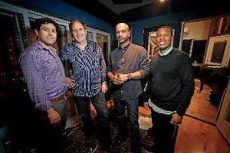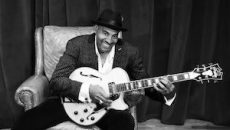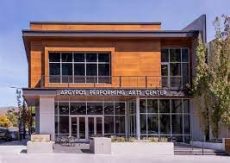
JACQUES LESURE JAM SESSION
Jacques is a Detroit native currently residing in Inglewood, California. His classic style along with his innovative yet sincere approach to the music are integral [arts of his signature sound. It’s a sound steeped in the rich tradition of mentors like George Benson, Kenny Burrell, and a host of others, but expressly through his own voice. It’s no secret that his music is rooted in the foundations of gospel, blues and improvised Black American music. It’s his belief that the sounds of “today” are equally as relevant as those of glorious days gone by. It is that synergy that makes his music swing with a style like no other.
Mr. Lesure is proudly associated with the prestigious WJ3 Records imprint and now has three recordings as an artist on the label. All have received great reviews including a four star rating by DownBeat magazine and one of the “Top 100” on the Jazz Week chart. He is an honorary member of GHJazz Collective where they are keeping jazz alive in Accra, Ghana at +233 Jazz Bar & Grill.
Jam Session takes place every Monday at 8:00pm through January (16, 23, 30)
More Posts: adventure,album,club,festival,genius,guitar,jazz,museum,music,preserving,restaurant,travel

Daily Dose Of Jazz…
Judd Proctor was born Procter on January 2, 1931 in Doncaster, Yorkshire, England. He played banjo in his youth and joined a local trio, but switched to guitar in his teens. He won a regional Melody Maker contest in a group, The Zetland Players. By the age of 18 he was conscripted into the Royal Air Force, where he met and was influenced by guitarist Ike Isaacs. After his military service ended, he worked in accountancy for British Rail, but soon left to join a dance band in Nottingham and became a professional musician.
After playing in various bands he joined Ray Ellington’s quartet in 1955, remaining for six years. He appeared on many radio broadcasts including The Goon Show. The early Sixties saw Proctor become a session musician, appearing on recordings by Cliff Richard, Helen Shapiro, The Springfields, Cilla Black, Serge Gainsbourg, Harry Nilsson and many others. In his later years he worked with the Benny Goodman Orchestra. He recorded some instrumentals under his own name, including the 1961 single Palamino/Nola, and a 1968 LP, Guitars Galore.
Judd appeared on many television shows with Ella Fitzgerald, Sammy Davis Jr., and Victoria Wood, and on many film soundtracks. The 1960s through the ‘80s had him touring with Stanley Black, a member of the Don Lusher Orchestra, and with the Bert Kaempfert Orchestra. His last and longest regular gig was providing incidental music for the TV comedy series Last of the Summer Wine.
Guitarist and session musician Judd Proctor, whose name was often misspelled on early recordings, transitioned on August 21, 2020 in Market Deeping, Lincolnshire, England at the age of 89.
More Posts: bandleader,guitar,history,instrumental,jazz,music

DAVE STRYKER
Dave Stryker-guitar, Jared Gold-B3, Walter Smith III tenor, McClenty Hunter-drums
Whether you’ve heard guitarist Dave Stryker leading his own group (with 34 CD’s as a leader to date), or as a featured sideman with Stanley Turrentine, Jack McDuff, and many others, you know why the Village Voice calls him “one of the most distinctive guitarists to come along in recent years.”
Hot House magazine awarded him Best Guitarist Fans Decision for 2017. He was recently voted once again as one of the top Jazz Guitarists in the 2022 Downbeat Critics and Readers Polls for the 15th time.
Dave’s last 5 CD’s have all gone to #1 on the JazzWeek Radio chart. His most recent “As We Are” features John Patitucci, Brian Blade, Julian Shore and a string quartet led by violinist Sara Caswell. Critics are calling it one of Dave’s greatest works yet. “Eight Track III” stayed at #1 on JazzWeek Radio chart for 6 straight weeks. “Messin’ with Mister T”, is a celebration of the man he worked with for over a decade — Stanley Turrentine, “Mister T” — with ten of the greatest tenor sax players on the scene today. It went to #1 on JazzWeek Radio and stayed in the Top 50 for 20 weeks and has received great reviews including 4 1/2 stars in Downbeat magazine.
Showtimes ~ 7:00pm | 9:00pm
More Posts: adventure,album,club,festival,genius,guitar,jazz,museum,music,preserving,restaurant,travel

ALLAN HARRIS BAND
Dinner & A Show
Ever since he burst on the jazz scene in the latter part of the twentieth century, the Brooklyn-born, Harlem-based vocalist/guitarist/bandleader/composer Allan Harris has reigned supreme as the most accomplished and exceptional singer of his generation. The ample and aural evidence of Harris’ moving and magisterial artistry can be heard on his fourteen recordings as a leader; his far-flung and critically-acclaimed concerts around the world, from Jazz at Lincoln Center in New York, and Washington DC’s Kennedy Center, to the 2012 London Olympics, and a many prestigious bookings in Europe, The Middle East and Asia.
Harris has won numerous awards which include, but are not limited to:
-New York Nightlife Award for “Outstanding Jazz Vocalist”
-Backstage Bistro Award for “Ongoing Achievement in Jazz”
-France’s Palmarès Award for 3rd best Jazz Vocal Album
-Harlem Speaks “Jazz Museum of Harlem Award”
-DownBeat Critics Award as “Rising Star Vocalist”
More Posts: adventure,album,club,festival,genius,guitar,jazz,museum,music,preserving,restaurant,travel,vocal

The Jazz Voyager
The Jazz Voyager is taking his next flight out to the great northwest to Idaho to pay a visit to a performing arts center called The Argyros. That is where the jazz vocalist Curtis Stigers will be performing for one night only. Besides his vocal talents he is also a songwriter, and plays the saxophone and guitar.
An intimate evening of songs and stories by this Emmy-nominated musician is something to anticipate. He has redefined the constitution of contemporary jazz singing, bringing new tunes to the Great American Songbook.
This is another first time discovery of the city and venue but I am excited to see what part of the country has to offer. Will definitely be dressed properly for the cold weather and hope any storms hold off. As always each flight I take has me masked as a preventative measure as these strains are continuing to mutate.
The center is located at 120 Main Street South, Ketchum 83340. The center’s number is 208-726-7872. For more information visit https://notoriousjazz.com/event/curtis-stigers.
More Posts: adventure,album,club,festival,genius,guitar,jazz,museum,music,preserving,restaurant,saxophone,travel,vocal



